Key takeaways:
- Understanding seasonality helps businesses tailor marketing strategies and inventory management to align with consumer demand effectively.
- Analyzing seasonal patterns through techniques like time series decomposition and rolling averages reveals hidden insights that guide marketing and sales tactics.
- Emotional connections tied to seasons can be leveraged to create targeted marketing campaigns that resonate with consumers, boosting engagement and sales.
- Collaboration across teams enhances forecasting by incorporating diverse perspectives and insights related to seasonal trends.
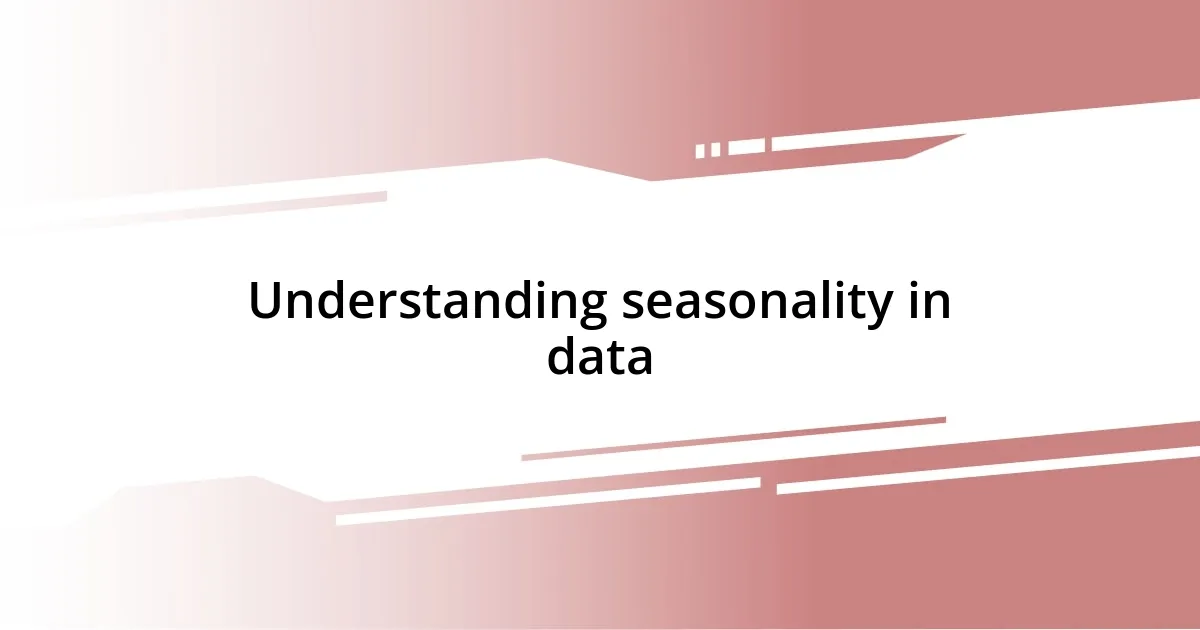
Understanding seasonality in data
Seasonality in data often reflects patterns that recur at regular intervals, and honestly, it fascinates me how these cycles can affect everything from sales to website traffic. I remember a time when I was analyzing e-commerce trends; noticing a spike in winter apparel sales every November was a real eye-opener. It made me realize how crucial it is to time marketing strategies just right.
Have you ever noticed how your own spending habits change with the seasons? I definitely do! In spring, I find myself buying more outdoor gear, and the data backs this up. Understanding these seasonal patterns helps businesses not just predict changes, but also tailor their offerings to meet consumer demand effectively.
Diving deeper, I often think about how seasonality isn’t just about the obvious months and holidays. It can also be influenced by broader economic shifts and cultural trends. For instance, during a recession, even holiday spending can diminish. It’s these intricate layers of insights that make analyzing seasonality so compelling to me. How have your experiences reflected this complexity?

Identifying seasonal patterns
Identifying seasonal patterns in data often requires a keen eye and a thoughtful approach. I remember sifting through monthly sales reports for a quirky little coffee shop I helped a friend analyze. The spikes in sales during the festive season were so pronounced, but what amazed me was how the slow months—like the beginning of summer—showcased an almost rhythmic decline in iced coffee purchases. This taught me that observing these trends meticulously can lead to smarter inventory decisions.
As I delved deeper into data visualization, I found that graphs and charts often crystallized complex patterns into something much more digestible. I’ve seen how adding trendlines can help identify those seasonal peaks and valleys clearer than a simple list of numbers could. When I shared those findings with my friend, their strategy for marketing—like pushing cold brews in summer—immediately shifted, showing how aligning promotions with seasonal trends could transform sales dynamics.
I often encourage others to embrace tools like time series analysis or seasonal decomposition every chance I get. By breaking down data points into seasonal components, we can uncover underlying rhythms that guide consumer behavior. For instance, while analyzing a local garden center’s sales, I noted how spring blooms were far more than just seasonal; they resonated with community events like Earth Day, creating a double impact that seasonal trends carried. So, how are you currently identifying patterns in your own data? It can be a game-changer.
| Technique | Description |
|---|---|
| Trend Analysis | Observing overall trends over time can help identify seasonal effects. |
| Time Series Decomposition | Breaking down data into seasonal, trend, and irregular components. |
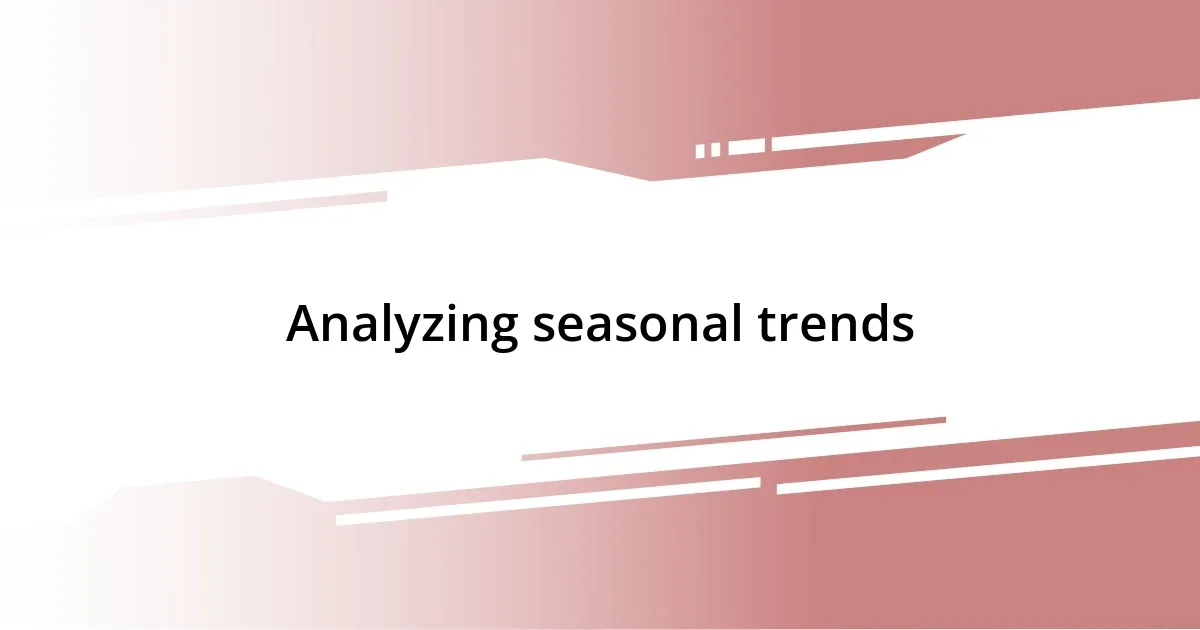
Analyzing seasonal trends
Analyzing seasonal trends brings a certain excitement, as it often reveals hidden stories within the data. I recall working on a marketing campaign for a seasonal dessert company, and I was amazed to discover that each year, traditional festive flavors triggered a nostalgic response that amplified customer engagement. The correlation between seasonal trends and customer emotions was palpable—understanding this allowed us to craft targeted promotions that resonated deeply during holidays.
To effectively analyze these trends, I’ve found it beneficial to focus on specific techniques:
- Rolling Averages: This helps smooth out fluctuations, making it easier to identify genuine seasonal patterns over time.
- Comparative Analysis: Looking at year-over-year changes provides clarity on what varies with the seasons and what remains constant.
- Consumer Surveys: Engaging directly with customers can unveil insights about seasonal preferences that raw data might obscure.
There’s an undeniable thrill in distilling data into meaningful insights, allowing businesses to engage with consumers on an emotional level. What about you? What exciting revelations have you found in your own seasonal analyses?

Practical applications of seasonality
Understanding the practical applications of seasonality can significantly enhance business strategies. In my experience working with a fashion retailer, I noticed how collection launches aligned with seasonal trends produced outstanding results. By introducing swimsuits in early spring, before summer kick-off, the store captured eager consumers who were ready to invest in new styles—proving that timing, influenced by seasonal data, can transform sales outcomes.
Using seasonality in inventory management is another powerful application. I once consulted for a local bakery that struggled with overstocking certain ingredients during winter. By analyzing past purchase patterns, I recommended adjusting their orders based on expected demand spikes for holiday treats, like cookies and pies. This shift not only minimized waste but also ensured they had enough stock during peak periods. Have you considered how seasonality in your inventory could reduce costs and improve efficiency?
Moreover, customer engagement benefits tremendously from recognizing seasonal trends. During a summer campaign for an outdoor equipment brand, I shared insights from past sales data that highlighted family camping gear jumping every June. This finding inspired us to launch engaging social media contests centered on summer adventures, leading to an impressive uptick in community participation and brand loyalty. How does your own seasonal awareness affect your engagement strategies? It’s all about connecting the dots between data and genuine experiences.
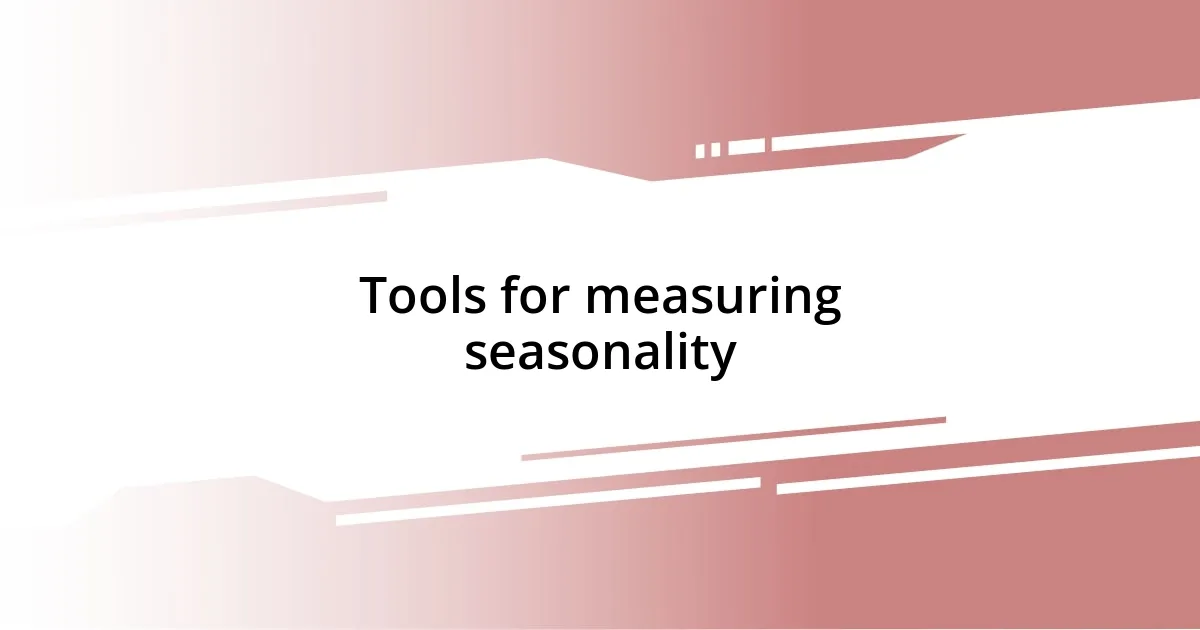
Tools for measuring seasonality
Using the right tools is essential for measuring seasonality effectively. One tool I’ve found particularly useful is time series decomposition. This method breaks down data into trend, seasonal, and irregular components, allowing me to isolate and analyze seasonal effects. I remember applying this technique while forecasting sales for a winter apparel brand; it revealed distinct buying patterns that shaped our marketing strategy.
Another valuable approach is employing software like Tableau or R for visualizing seasonal trends. By creating visual representations, I can easily spot patterns that may not be immediately obvious in raw data. During a project for a tourism company, I used R to plot visitor numbers over the months. The seasonal highs and lows sprang to life in the graphs, allowing us to tailor our promotional efforts effectively.
Lastly, I encourage using automated tools for gathering and analyzing consumer sentiment during different seasons. Combining tools like social media analytics with customer feedback systems has transformed how I approach seasonal campaigns. I recall a project where monitoring real-time customer reactions helped us adapt our messaging on the fly during a summer sale. Isn’t it fascinating how technology can empower us to connect more deeply with our audience based on seasonal insights?
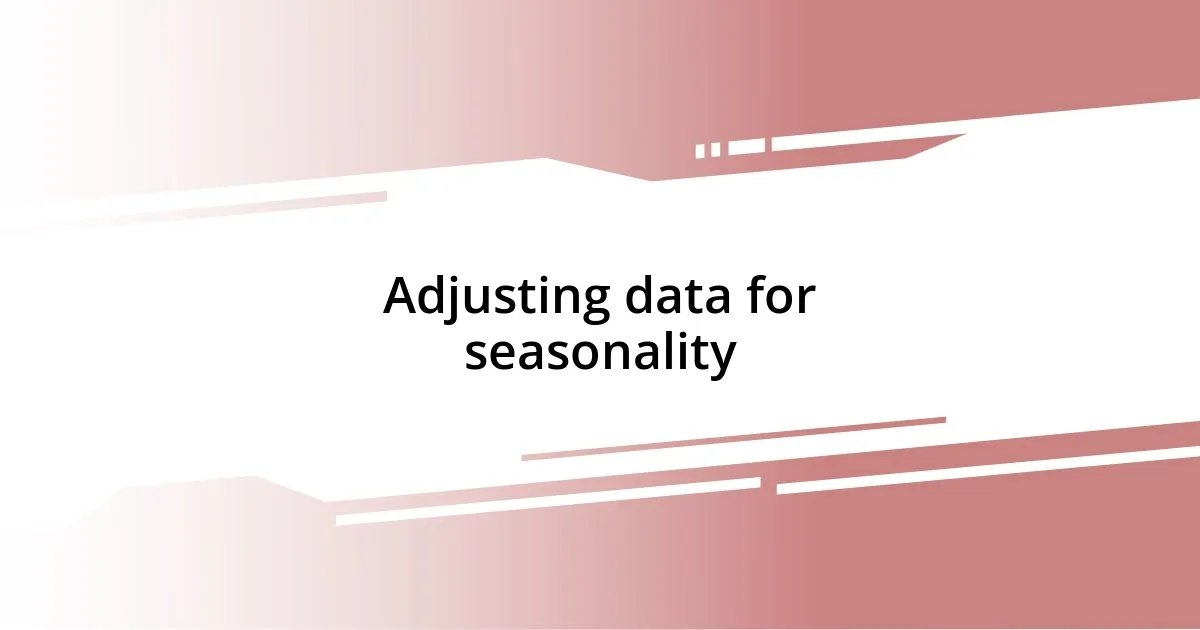
Adjusting data for seasonality
Adjusting data for seasonality is crucial for accurate forecasting. I vividly remember working with an e-commerce start-up that initially relied solely on annual averages for sales predictions. After introducing seasonal adjustments based on monthly sales trends, we saw a remarkable increase in inventory efficiency and customer satisfaction—demonstrating how timely data adjustments can lead to better outcomes.
A common method I utilize is moving averages, which smooth out fluctuations in the data by averaging sales over a defined period. When I applied this technique while analyzing a seasonal event, like Black Friday sales, I noticed patterns that helped pinpoint the best timing for restocking. Isn’t it interesting how uncovering those insights can transform stressful situations into opportunities for growth?
Ultimately, I believe it’s essential to continuously revisit and refine adjustments as new data emerges. For instance, during a quarterly review, I discovered that last year’s holiday shopping surge had shifted earlier due to changing consumer behaviors. By proactively adjusting our strategies, we not only optimized our marketing efforts but also positioned ourselves for success as needs evolved. How often do you evaluate your approach to seasonal data? Keeping a pulse on these trends can genuinely make a difference.
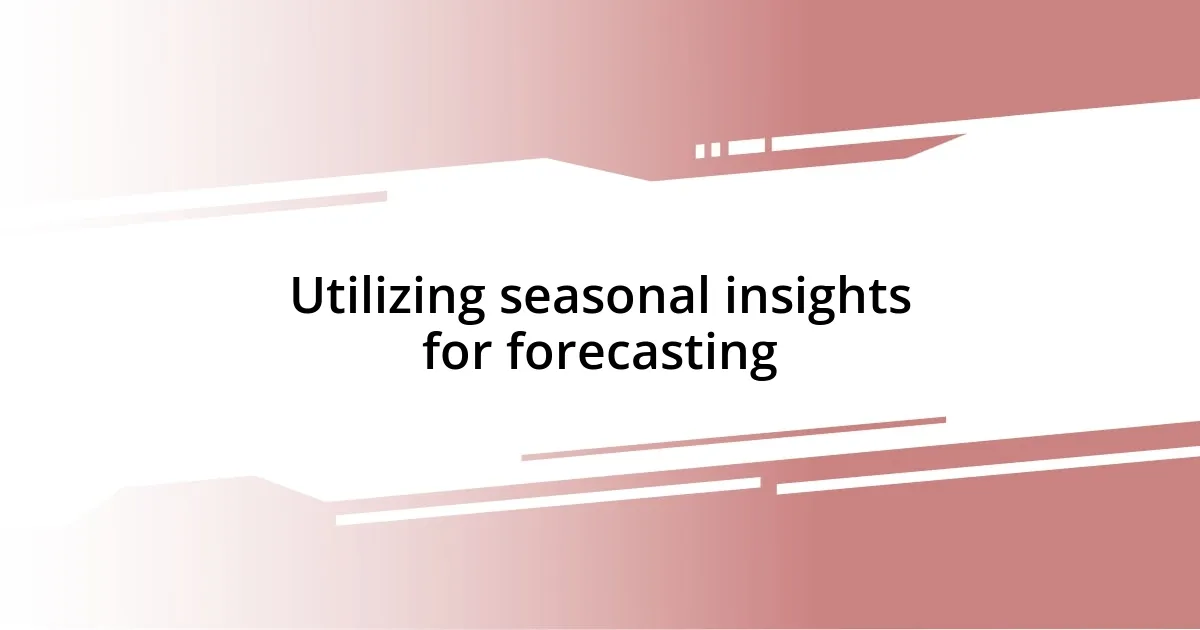
Utilizing seasonal insights for forecasting
Utilizing seasonal insights for forecasting can transform how we anticipate trends and make decisions. I recall a time when I analyzed retail data just before Halloween. By diving into past sales during that specific season, I discovered a surprising rebound in costume sales mid-October. This insight allowed our team to adjust inventory levels proactively, which led to a noticeable spike in sales that year. The thrill of seeing our preparations pay off was incredibly rewarding.
Another key aspect is recognizing the emotional elements tied to seasons. For example, during the festive holiday season, consumers often engage in impulse buying, driven by nostalgia and the desire to celebrate. By leveraging this emotional connection in our forecasting, I was able to develop targeted campaigns that resonated deeply with our audience. Have you ever felt the pressure to find the perfect gift? Tapping into these sentiments can help make our forecasting efforts not just numbers-driven, but truly consumer-centric.
Finally, I can’t stress enough how valuable it is to share insights across teams. Collaborating with marketing, sales, and product development can uncover perspectives that inform better forecasts. For instance, during a quarterly meeting, our findings around Valentine’s Day buying trends sparked a cross-departmental initiative that increased our promotional effectiveness. Isn’t it amazing how working together around seasonal insights can lead to breakthroughs we might not have discovered alone?












